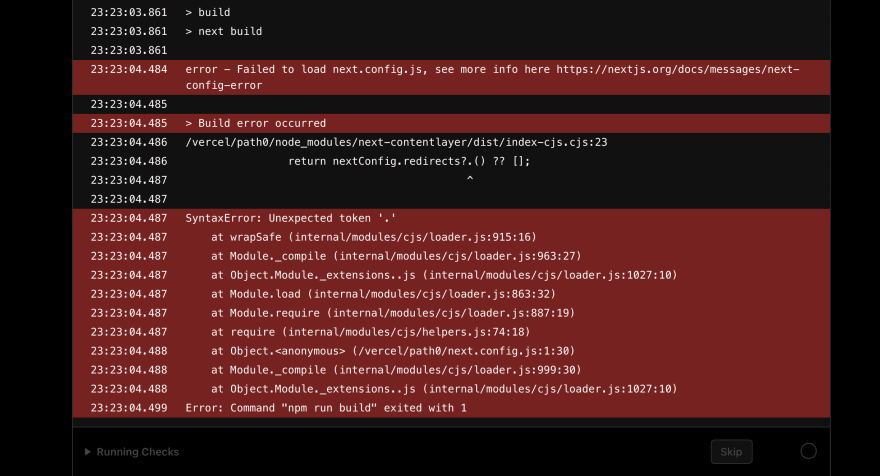Note: Contentlayer is still in development and some APIs might change!
What is Contentlayer?
Contentlayer turns your content into data - making it super easy to import MD(X) and CMS content in your app.
Automatic Setup
The easiest way to create a new Next.js app with Contentlayer is by using official Next.js example, which sets up everything automatically for you. To create a project, run:
npx create-next-app --example with-contentlayer with-contentlayer-app
# or
yarn create next-app --example with-contentlayer with-contentlayer-app
After the installation is complete:
- Run
npm run devoryarn devto start the development server onhttp://localhost:3000. - Visit
http://localhost:3000to view your application.
Manual Setup
Install Contentlayer in your Next.js app
npm install contentlayer next-contentlayer
# or
yarn add contentlayer next-contentlayer
Add your Contentlayer config
Create contentlayer.config.js file at the root of the project with the following code.
import { defineDocumentType, makeSource } from "contentlayer/source-files";
const Post = defineDocumentType(() => ({
name: "Post",
filePathPattern: `**/*.md`,
contentType: "markdown",
fields: {
title: { type: "string", required: true },
date: { type: "string", required: true },
},
computedFields: {
slug: {
type: "string",
resolve: (doc) => doc._raw.sourceFileName.replace(/\.md/, ""),
},
},
}));
export default makeSource({
contentDirPath: "posts",
documentTypes: [Post],
});
Set up Next.js plugin in next.config.js (optional: enables live-reload and build setup)
const { withContentlayer } = require("next-contentlayer");
module.exports = withContentlayer({
// Your Next.js config...
});
Add a jsconfig.json file
{
"compilerOptions": {
"baseUrl": ".",
"paths": {
"contentlayer/generated": ["./.contentlayer/generated"]
}
},
"include": [".contentlayer/generated"]
}
In case you are using TypeScript in your project you already have a tsconfig.json to which you will add these lines of code to.
{
"compilerOptions": {
"baseUrl": ".",
"paths": {
// These option allow you to configure module aliases.
// So you will import contentlayer generated content from "contentlayer/generated" instead of "./.contentlayer/generated"
+ "contentlayer/generated": ["./.contentlayer/generated"]
}
},
"include": [
"next-env.d.ts",
"**/*.ts",
"**/*.tsx",
+ ".contentlayer/generated"
],
}
Add some posts
- Add
postsfolder at the root of your app(Where your content will live). - Add
.mdfiles(e.g.pre-rendering.md). - Add your content(You can write anything you want, This is just an example).
---
title: "Two Forms of Pre-rendering"
date: "2020-01-01"
---
Next.js has two forms of pre-rendering: **Static Generation** and **Server-side Rendering**. The difference is in **when** it generates the HTML for a page.
- **Static Generation** is the pre-rendering method that generates the HTML at **build time**. The pre-rendered HTML is then _reused_ on each request.
- **Server-side Rendering** is the pre-rendering method that generates the HTML on **each request**.
Importantly, Next.js lets you **choose** which pre-rendering form to use for each page. You can create a "hybrid" Next.js app by using Static Generation for most pages and using Server-side Rendering for others.
Fetch and display your posts
import Link from "next/link";
import { allPosts } from "contentlayer/generated";
import { pick } from "@contentlayer/client";
export default function Home({ posts }) {
return (
<section>
<ul>
{posts.map(({ slug, date, title }) => (
<li key={slug}>
<Link href={`/posts/${slug}`}>
<a>{title}</a>
</Link>
<br />
<small>{date}</small>
</li>
))}
</ul>
</section>
);
}
// Statically fetch all posts
export async function getStaticProps() {
const posts = allPosts.map((post) => pick(post, ["title", "date", "slug"]));
return { props: { posts } };
}
Create dynamic routes for each post
In this section, you should know how dynamic routes works in Next.js,
Add posts/[slug].js inside pages folder.
import { allPosts } from 'contentlayer/generated'
export default function Post({ post }) {
return (
<article>
<h1>{post.title}</h1>
<div>{post.date}</div>
<div dangerouslySetInnerHTML={{ __html: post.body.html }} />
</article>
)
}
export async function getStaticPaths() {
return {
paths: allPosts.map((p) => ({ params: { slug: p.slug } })),
fallback: false,
}
}
// Statically fetch post by slug
export async function getStaticProps({ params }) {
const post = allPosts.find((post) => post.slug === params?.slug)
return { props: { post } }
}
Now we are done 🎉, Check http://localhost:3000 to see the results!
Conclusion
In this guide, We learned about how we can integrate Next.js with Contentlayer,
As well as how we can display all posts and post by slug.
An online demo of the application that we built is hosted on Vercel
and the code is available on GitHub for TypeScript version check out this GitHub branch.
Thanks to Johannes Schickling for providing this really great tool!
Make sure to contact me if you have any questions.



Top comments (7)
Hi i have tried to use it and in vercel while deployment i am facing a issue as below

Thanks for the response!
you can find it here.
github.com/achuthhadnoor/www/blob/...
Your
next.config.jslooks fine, I think you should open an issue in contentlayer repository.looks like you are using the same version of the next-contentlayer , contentlayer , v0.0.33
build works fine in local
but when i deploy to vercel it fails with the error
Yes, That's a weird error I have never faced something similar.
So the issue was with the node version on vercel the required was >=14 but i had 12... When i upgraded then it worked